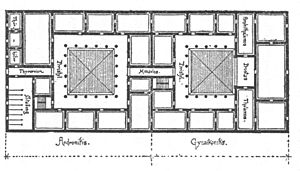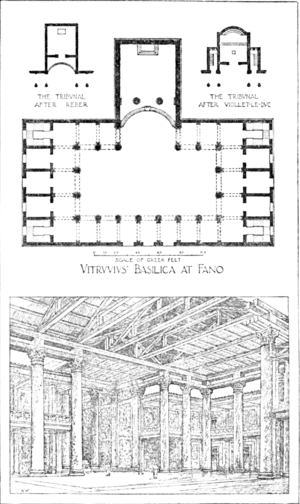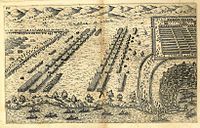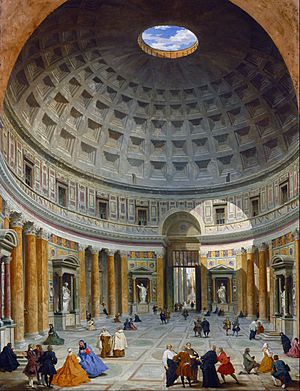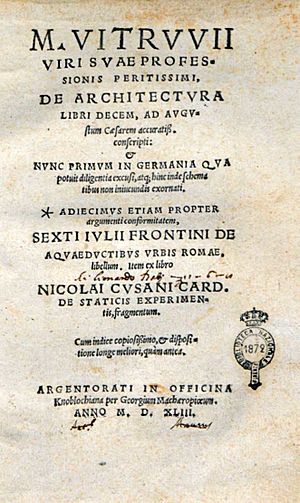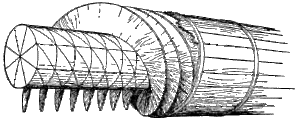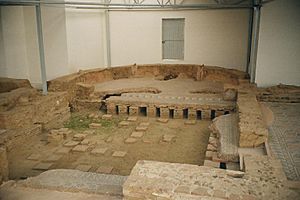Vitruvius facts for kids
Quick facts for kids
Vitruvius
|
|
|---|---|
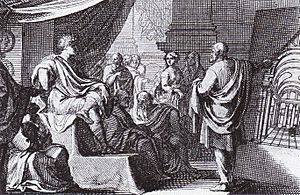
A 1684 depiction of Vitruvius (right) presenting De Architectura to Augustus
|
|
| Born | 80–70 BC |
| Died | 15 BC (aged 55–65) |
| Nationality | Roman |
| Occupation |
|
|
Notable work
|
De architectura |
Vitruvius (/vɪˈtruːviəs/; around 80–70 BC – after 15 BC) was a famous Roman architect and engineer. He lived during the 1st century BC. He is best known for his big book called De architectura (which means "On Architecture").
Vitruvius believed that all buildings should have three important qualities: strength, usefulness, and beauty. These ideas became very important in Roman architecture. His thoughts on perfect design, especially how it relates to the human body, inspired the famous Vitruvian Man drawing by Leonardo da Vinci.
Contents
Who Was Vitruvius?
Not much is known about Vitruvius's early life. We learn most about him from his own writings. He worked in the Roman military as an artilleryman. This means he was skilled with war machines.
He was probably a senior officer in charge of experts who operated artillery like ballista and scorpio machines. These were used to attack cities during sieges. Some people think he worked with Julius Caesar's main engineer, Lucius Cornelius Balbus.
Vitruvius's Military Experience
As an army engineer, Vitruvius specialized in building war machines. He helped create powerful tools like ballista and scorpio artillery. These were used to attack enemy cities during sieges.
He likely served in many places, including North Africa, Spain, and Gaul (modern France). He might have been present at famous battles. These include the siege of Avaricum and the Battle of Alesia during the Gallic War.
What Did Vitruvius Build?
Vitruvius was an architect, but in Roman times, this job was much broader. Architects were also like civil engineers, military engineers, and city planners. They knew about building, materials, and even how to design cities.
He is known for describing how to build aqueducts, which were water channels. He also wrote about how to place special pots called echea in theaters to make sound better. The only building we know he designed is a basilica in a town called Fano. This building was finished in 19 BC, but it has since disappeared.
Later in his life, the emperor Augustus helped Vitruvius financially. This support allowed him to focus on his important writings.
De Architectura: His Famous Book
Vitruvius wrote a very important book called De architectura, libri decem. This means "The Ten Books on Architecture." It was written in Latin and dedicated to Emperor Augustus. In the book, Vitruvius wanted to share his knowledge about building quality with the emperor.
This book is the only major work on architecture that survived from ancient times. It greatly influenced artists, thinkers, and architects from the Renaissance onwards. Famous people like Leonardo da Vinci and Michelangelo were inspired by it.
The Three Qualities of Buildings
Vitruvius is famous for saying that a building must have three main qualities:
- Strength (firmitas): It must be strong and last a long time.
- Usefulness (utilitas): It must be practical and serve its purpose well.
- Beauty (venustas): It must be pleasing to look at.
These are sometimes called the Vitruvian virtues or the Vitruvian Triad.
Architecture and Nature
Vitruvius believed that architecture copied nature. Just as birds build nests, humans built homes from natural materials. These homes protected them from the weather. As people got better at building, they created different styles, like the Doric, Ionic, and Corinthian columns.
This led to understanding perfect proportions, especially in the human body. This idea inspired Leonardo da Vinci's famous drawing, the Vitruvian Man. This drawing shows a human body perfectly fitting inside a circle and a square.
What Else is in the Book?
Vitruvius's book covers many topics. He wrote about how architects should be educated. He said they should know about drawing, geometry, lighting, history, philosophy, music, and even medicine and law.
He divided architecture into three main parts:
- Building (public and private structures)
- Making sundials and water clocks
- Designing and using machines for building and war
He also wrote about city planning, including walls, gates, theaters, markets, baths, and temples. He even discussed how climate affects house design and how to choose good locations for cities.
The Vitruvian Man
The idea for the Vitruvian Man drawing came from Vitruvius's writings. He described the human body as the main source of perfect proportions. This drawing shows the human body's natural balance. It also suggests a connection between human design and the order of the universe.
Rediscovery of De Architectura
Vitruvius's book was "rediscovered" in 1414. A scholar named Poggio Bracciolini found it in a library in Switzerland. This discovery was very important. It helped bring ancient Roman ideas back into use during the Renaissance.
Many copies and translations of the book were made. The first printed version came out in 1486. Later editions included illustrations based on Vitruvius's descriptions. These illustrated books inspired architects for centuries. They influenced the styles of Renaissance, Baroque, and Neoclassical architecture.
For example, Filippo Brunelleschi used ideas from De Architectura and Roman buildings like the Pantheon to design the huge dome of the Florence Cathedral.
Roman Technology and Innovations
Vitruvius's books also tell us a lot about Roman technology. He described many machines and building methods.
Machines and Tools
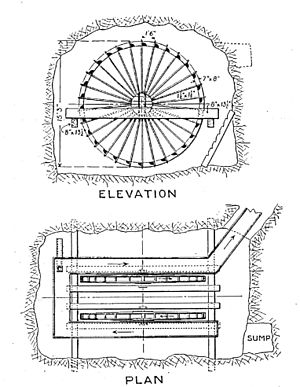
He wrote about different machines used in building. These included hoists, cranes, and pulleys. He also described war machines like catapults and ballistae. Since he was an engineer, he likely spoke from his own experience.
He also explained how to build sundials and water clocks. He even described an aeolipile, which was a simple steam engine. It was used to show how air moves.
Water Systems
Vitruvius detailed how to build aqueducts. He explained how to survey the land and choose the right materials. Many Roman aqueducts, like the Pont du Gard, still stand today. He also described the inverted siphon, a way to move water across valleys.
He wrote about machines for moving water, like the Archimedes' screw. This device was used to lift water for irrigation and to drain mines. Remains of these water wheels have been found in old mines in Spain and Wales.
Building Materials
Vitruvius described many different construction materials. He wrote about how to use concrete and lime. He also warned about the dangers of using lead pipes for drinking water. He suggested using clay pipes instead, which was a very smart idea for health.
He also shared the famous story of Archimedes. Archimedes discovered how to measure the volume of an object by seeing how much water it displaced. This happened while he was in his bath, leading to his famous shout of Eureka!
Heating Systems
Vitruvius described clever ways to heat buildings. He wrote about the hypocaust, a type of central heating. Hot air from a fire was channeled under the floor and inside the walls. This kept public baths and homes warm. He gave instructions on how to design these systems to save fuel.
Vitruvius's Legacy
Vitruvius's ideas have had a lasting impact.
- The Vitruvian Man drawing by Leonardo da Vinci is a direct result of his writings.
- Books like Vitruvius Britannicus and Den Danske Vitruvius were named after him. They focused on British and Danish architecture.
- A small crater and a mountain on the Moon are named after him.
- His principles are still used today in tools that measure building quality.
See also
 In Spanish: Vitruvio para niños
In Spanish: Vitruvio para niños
- Roman architecture
- Roman aqueducts
- Roman engineering
- Roman technology
- Vitruvian Man


